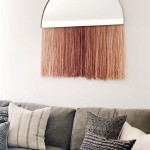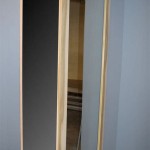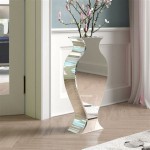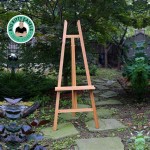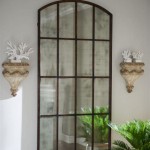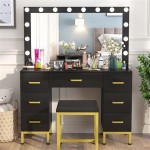Large Antique Mirrors: A Reflection of History and Style
Large antique mirrors offer a unique blend of historical significance and decorative appeal. They can transform a space, adding a sense of grandeur and depth while serving as a window into the past. Understanding the nuances of antique mirrors, from their construction to their value, is crucial for both collectors and decorators.
Key Considerations When Choosing a Large Antique Mirror
Selecting a large antique mirror requires careful consideration of several factors to ensure it complements the intended space and aligns with personal preferences.
- Size and Scale: The mirror's dimensions must be proportional to the room and surrounding furniture.
- Frame Style and Material: The frame's design and material (e.g., wood, gilt, metal) should harmonize with the overall décor.
- Mirror Condition: Examine the mirror for signs of age, such as foxing, silvering loss, or scratches. These imperfections can add character but also affect value.
- Period and Provenance: Knowing the mirror's historical period and origin can enhance its value and interest.
Popular Styles of Antique Mirrors
Antique mirrors encompass a variety of styles, each reflecting the aesthetic trends of its era. Identifying these styles can assist in authentication and appreciation.
- Victorian: Often characterized by ornate carved wooden frames, featuring elaborate floral or geometric motifs.
- Art Deco: Known for geometric shapes, clean lines, and the use of materials like chrome and ebony.
- Federal: Typically feature simpler, neoclassical designs with gilded or mahogany frames.
- French Louis XV: Distinguished by rococo elements, including asymmetrical curves, shell motifs, and intricate carvings.
Understanding Mirror Construction and Materials
The materials and techniques used in creating antique mirrors significantly impact their appearance and durability. Recognizing these elements is crucial for proper care and restoration.
- Glass: Older mirrors often used thicker glass, sometimes with imperfections like bubbles or waves, adding to their unique character.
- Backing: Traditionally, silvering was applied to the back of the glass. Over time, this can deteriorate, leading to foxing or black spots.
- Frame Materials: Wood (often carved and gilded), gesso, metal, and resin were common frame materials, each offering distinct aesthetic qualities.
Caring for Large Antique Mirrors
Preserving the beauty and integrity of antique mirrors requires proper care and maintenance.
- Cleaning: Gentle cleaning with a soft, damp cloth is recommended. Avoid harsh chemicals that can damage the frame or silvering.
- Handling: Always handle large antique mirrors with care, supporting the frame and avoiding pressure on the glass.
- Environment: Protect mirrors from excessive humidity, direct sunlight, and extreme temperature fluctuations to prevent further deterioration.
Evaluating the Value of Antique Mirrors
Several factors contribute to the value of an antique mirror, making appraisal a complex process.
- Rarity: Uncommon styles, sizes, or materials can significantly increase value.
- Condition: Well-preserved mirrors generally command higher prices than those with significant damage.
- Provenance: A documented history of ownership can enhance a mirror's value and historical significance.
- Maker: Mirrors crafted by renowned makers or workshops are often more desirable and valuable.
- Current Market Trends: Fluctuations in the antiques market can influence the value of specific styles and periods.
Displaying Large Antique Mirrors
Strategic placement maximizes the impact of a large antique mirror and enhances the overall aesthetic of a room.
- Focal Point: Position the mirror above a fireplace mantel or on a prominent wall to create a captivating focal point.
- Light Reflection: Place the mirror opposite a window or light source to amplify natural light and create a brighter, more spacious feel.
- Creating Illusions of Space: In smaller rooms, large mirrors can create an illusion of depth and expand the perceived space.
Restoration and Repair
Restoring an antique mirror requires specialized knowledge and skills to preserve its historical integrity.
- Professional Assessment: Consulting a qualified antique mirror restorer is essential for accurate assessment and appropriate restoration techniques.
- Silvering Replacement: Damaged silvering can be replaced using traditional or modern methods.
- Frame Repair: Cracks, chips, or missing elements in the frame can be carefully repaired and restored.
Researching Antique Mirrors
Thorough research is invaluable for understanding the history, style, and value of antique mirrors.
- Antique Guides and Books: Numerous resources provide detailed information on different periods and styles.
- Online Resources: Auction websites, antique dealer sites, and museum collections offer valuable insights.
- Antique Shows and Fairs: Attending antique shows provides opportunities to examine mirrors firsthand and interact with experts.

Antique Gold Framed Mirror For Vintage Home Decor

Large Antique Wall Mirror 1860s For At Pamono

Large Antique French Gold Louis Philippe Mirror 19th Century Antiques Mantel Mirrors Fireplace

Large Antique French Mirror 337107 Ingantiques Co

Antique Large Mirrors

779 Antique Large Mirrors For Ingantiques Co

Antique Large Mirrors

Very Large Gilt Mirror Antique Mirrors At Straffan Antiques

Antique Victorian Mantle Mirror Wells Reclamation

Large Antique Gold French Framed Decorative Rococo Ornate Wall Mirror Opera

